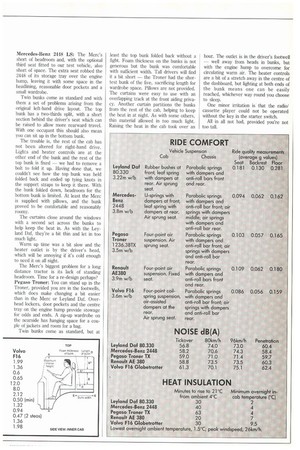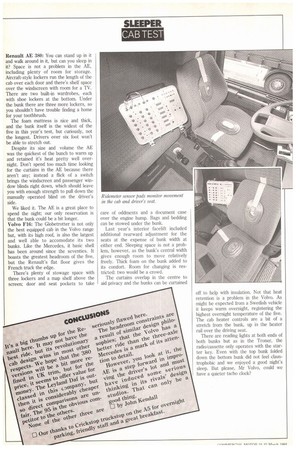SLEEPER APPEAL
Page 38

Page 39

Page 40

If you've noticed an error in this article please click here to report it so we can fix it.
Leyland Daf FT 80.330: The Series 80 is best suited to the occasional night out, not least when it comes to physical space because you can't stand up to change in it. Undressing is done with a hunchback of Notre Dame stoop perhaps Leyland Daf should have kept the original Interstate high-roof option.
At least this lack of size means that it doesn't take long for the cab heater to do its stuff. On the minus side, the all-round glazing might be good for vision but is bad news for insulation the cold woke us more than once.
The blue striped curtains are relatively easy to set up, although the metal runner and nylon hooks aren't too smooth. The double fold over the door took a bit of figuring out but we soon got the hang of it. The curtains stop at the front blinds, which pull right down on a ratchet. Privacy could be better studs hold the side curtains in place but there's nothing to stop the back ones sliding around. Generally, they're a bit flimsy. Under the glare of the Crickstop floodlights they let a fair amount of light in.
Interior lighting is good and easily reached. Storage space is at a premium, consisting of a split compartment beneath the bunk, shared with the Eberspacher cab heater; a headliner shelf; small cubby box and trays on the engine cover; with a small pocket and some space at the nearside end of the bunk.
The bunk is extremely firm, which is doubtless good for the back, even if it doesn't feel like it initially. There's no foam block for a pillow a common complaint of sleeper cabs, but one we'd like to see answered nonetheless.
Lasting impressions are that it's cosy to the point of being cramped, but up to a couple of nights out a week or a kip during a break your classic gaffer's motor. Mercedes-Benz 2448 LS: The Merc's short of headroom and, with the optional third seat fitted to our test vehicle, also short of space. The extra seat robbed the 2448 of its storage tray over the engine hump, leaving it with some space in the headlining, reasonable door pockets and a small wardrobe.
Twin bunks come as standard and with them a set of problems arising from the original left-hand drive layout. The top bunk has a two-thirds split, with a short section behind the driver's seat which can be raised to allow more rearward travel. With one occupant this should also mean you can sit up in the bottom bunk.
The trouble is, the rest of the cab has not been altered for right-hand drive. Lights and heater controls are at the other end of the bunk and the rest of the top bunk is fixed we had to remove a bolt to fold it up. Having done that, we couldn't see how the top bunk was held folded back and ended up tying knots in the support straps to keep it there. With the bunk folded down, headroom for the bottom bunk is limited. At least the Merc is supplied with pillows, and the bunk proved to be comfortable and reasonably roomy.
The curtains close around the windows with a second set across the bunks to help keep the heat in. As with the Leyland Daf, they're a bit thin and let in too much light.
Warm up time was a bit slow and the heater outlet is by the driver's head, which will be annoying if it's cold enough to need it on all night.
The Merc's biggest problem for a long distance tractor is its lack of standing headroom. Time for a re-design perhaps? Pegaso Troner: You can stand up in the Troner, provided you are in the footwells, which does make changing a bit easier than in the Merc or Leyland Daf. Overhead lockers, door pockets and the centre tray on the engine hump provide stowage for odds and ends. A zip-up wardrobe on the nearside has hanging space for a couple of jackets and room for a bag.
Twin bunks come as standard, but at least the top bunk folded back without a fight. Foam thickness on the bunks is not generous but the bunk was comfortable with sufficient width. Tall drivers will find it a bit short the Troner had the shortest bunk of the five, sacrificing length for wardrobe space. Pillows are not provided. The curtains were easy to use with an overlapping track at the front aiding privacy. Another curtain partitions the bunks from the rest of the cab, helping to keep the heat in at night. As with some others, thin material allowed in too much light. Raising the heat in the cab took over an hour. The outlet is in the driver's footwell well away from heads in bunks, but with the engine hump to overcome for circulating warm air. The heater controls are a bit of a stretch away in the centre of the dashboard, but lighting at both ends of the bunk means one can be easily reached, whichever way round you choose to sleep.
One minor irritation is that the radio/ cassette player could not be operated without the key in the starter switch.
All in all not bad, provided you're not too tall.
Renault AE 380: You can stand up in it and walk around in it, but can you sleep in
it? Space is not a problem in the AE, including plenty of room for storage. Aircraft-style lockers run the length of the cab over each door and there's shelf space over the windscreen with room for a TV. There are two built-in wardrobes, each with shoe lockers at the bottom. Under the bunk there are three more lockers, so you shouldn't have trouble finding a home for your toothbrush.
The foam mattress is nice and thick, and the bunk itself is the widest of the five in this year's test, but curiously, not the longest. Drivers over six foot won't be able to stretch out.
Despite its size and volume the AE was the quickest of the bunch to warm up and retained it's heat pretty well overnight. Don't spend too much time looking for the curtains in the AE because there aren't any; instead a flick of a switch brings the windscreen and passenger window blinds right down, which should leave you with enough strength to pull down the manually operated blind on the driver's side.
We liked it. The AE is a great place to spend the night; our only reservation is that the bunk could be a bit longer.
Volvo F16: The Globetrotter is not only the best equipped cab in the Volvo range but, with its high roof, is also the largest and well able to accomodate its two bunks. Like the Mercedes, it basic shell has been around since the seventies. It boasts the greatest headroom of the five, but the Renault's flat floor gives the French truck the edge.
There's plenty of stowage space with three lockers and a map shelf above the screen; door and seat pockets to take
care of oddments and a document case over the engine hump. Bags and bedding can be stowed under the bunk.
Last year's interior facelift included additional rearward adjustment for the seats at the expense of bunk width at either end. Sleeping space is not a problem, however, as the bunk's central width gives enough room to move relatively freely. Thick foam on the bunk added to its comfort. Room for changing is restricted: two would be a crowd.
The curtains overlap in the centre to aid privacy and the bunks can be curtained off to help with insulation. Not that heat retention is a problem in the Volvo. As might be expected from a Swedish vehicle it keeps warm overnight, registering the highest overnight temperature of the five. The cab heater controls are a bit of a stretch from the bunk, up in the heater rail over the driving seat.
There are reading lights at both ends of both bunks but as in the Troner, the radio/cassette only operates with the starter key. Even with the top bunk folded down the bottom bunk did not feel claustrophobic and we enjoyed a good night's sleep. But please, Mr Volvo, could we have a quieter tacho clock?
























































































